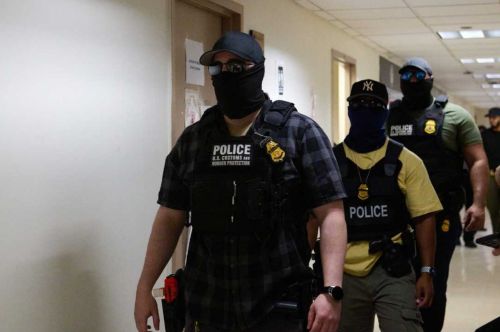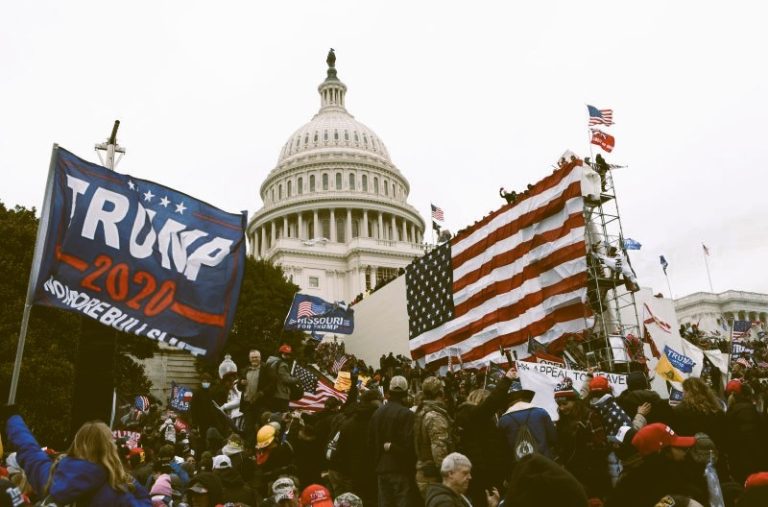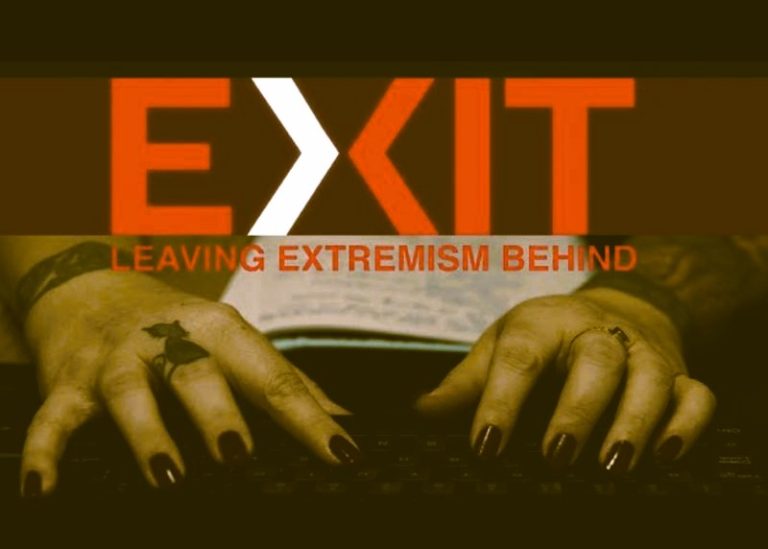

From Hitler’s Brownshirts to the covert forces of military juntas, the common thread is the erasure of accountability. The United States now stands at a crossroads.

By Matthew A. McIntosh
Public Historian
Brewminate
Secret Policing, Extremism, and the Fight for Accountability
In cities across the United States, residents have reported scenes that look more like abductions than law enforcement. Masked men in tactical gear, faces obscured, scoop people off the streets into unmarked vehicles, often without showing identification or explaining charges. Civil liberties advocates warn that such practices by Immigration and Customs Enforcement (ICE) strip away the basic principles of transparency and accountability. Commentators have asked bluntly: what are ICE agents hiding behind the mask?
In California, reporters have documented how masked agents have blurred the line between official enforcement and something far more secretive. A Voice of OC investigation titled “Unmasking ICE” raised alarm about the anonymity of those carrying out sweeps in immigrant neighborhoods, while KQED uncovered cases in which communities could not even verify if those making arrests were legitimate officers. In the absence of clear identification, the public is left to wonder: are these federal agents, contractors, or something far more troubling: deputized members of extremist groups operating under the cover of government authority?
Recent Incidents and Public Reporting
Reports from across the country paint a disturbing picture of how ICE operations have changed in recent years. Agents in masks, without badges or name tags, have carried out street arrests and neighborhood sweeps that resemble covert raids more than accountable policing. The absence of visible identification makes it impossible for community members to know who is detaining them, or even to confirm whether those conducting the arrests are legitimate officers.
Critics argue that concealing identity undermines the very premise of lawful enforcement, reducing transparency and creating the conditions for abuse. These concerns are echoed in Orange County, where Voice of OC reporters investigated anonymous sweeps and urged lawmakers to “Unmask ICE”. Local officials admitted that even they struggled to verify the chain of command in these cases.
California has been a flashpoint. A KQED News investigation asked a simple but chilling question: “Who are the people rounding up immigrants in California?”. Their reporting described masked groups carrying out arrests without providing paperwork or due process, sometimes in unmarked vehicles, leaving families with no idea who had taken their loved ones or where they had been transported. Such operations evoke not the rule of law but the tactics of secret police forces historically used to terrorize populations.
The Legal, Constitutional, and Ethical Stakes
Law enforcement in a democracy is meant to be visible, identifiable, and accountable. Badges and nameplates are not ornamental; they are safeguards, ensuring that officers can be held responsible for their actions. When ICE agents conceal their faces and operate without identification, they blur the line between public service and clandestine force. As legal scholars point out, this practice not only undermines trust but also raises serious constitutional questions about due process and equal protection under the law.
Ethically, the issue is just as stark. Modern policing in democratic societies is grounded in what are often called the “Peelian principles,” the idea that the legitimacy of law enforcement rests on public consent and visible accountability. A masked officer removes that visibility, making it impossible for the public to distinguish between lawful authority and coercive force. The result is not security, but fear. And history suggests that once secrecy becomes normalized, accountability disappears.
Historical and Comparative Precedents
The sight of masked agents seizing people without identification has disturbing historical echoes. In the early 20th century, Adolf Hitler’s paramilitary wing, the Sturmabteilung or Brownshirts, functioned as an unofficial enforcement arm, intimidating political opponents and immigrants alike. Their power rested not only in violence but in anonymity: a faceless mass whose actions blurred the line between state authority and mob rule. This blurring gave the Nazi regime plausible deniability while cultivating fear in the streets.
Authoritarian regimes have long relied on such tactics. In the waning days of the Weimar Republic, Germany’s “Black Reichswehr” operated as a clandestine paramilitary force, carrying out extrajudicial arrests and assassinations under the guise of patriotism. Like the Brownshirts, their lack of clear accountability meant abuses could flourish unchecked. The principle was simple: if people cannot identify who is detaining them, they cannot hold those actors responsible. The mask becomes not only a shield for the face but also for impunity.
Modern parallels are also evident. Across Latin America in the 1970s and 1980s, “disappeared” citizens were often taken by masked or unmarked forces claiming state authority, leaving families with no recourse to challenge the arrests. These practices were not incidental; they were designed to terrorize communities into silence. The resemblance to reports of ICE agents operating in unmarked vehicles and concealing their identities today is striking, suggesting that the United States is veering into territory more commonly associated with authoritarian policing than democratic governance.
Even within the United States, the dangers of masked enforcement have been recognized. During the 2020 protests in Portland, federal agents wearing camouflage and no visible identification detained demonstrators in unmarked vans, sparking outrage and lawsuits. Civil liberties advocates warned at the time that such tactics mirrored those of secret police in authoritarian regimes. Now, with ICE adopting similar practices on a broader scale, the question is whether history’s lessons are being ignored and whether the United States is normalizing the very tactics it once condemned abroad.
Militia Links, Extremism, and the Risk of Collusion
The anonymity of masked enforcement raises an even more unsettling possibility: infiltration or collaboration with extremist groups. Law enforcement agencies in the United States have long faced warnings about white supremacist and far-right militancy within their ranks. A report by the Brennan Center documented the persistent problem of far-right extremism in U.S. law enforcement, noting that infiltration often goes unchecked due to weak oversight and limited accountability.
In this context, the specter of January 6 looms large. Groups like the Proud Boys and Oath Keepers, many of whom have been convicted for their roles in the Capitol attack, remain active and vocal supporters of Trump. Critics now warn that the absence of visible identification on ICE agents makes it impossible to know whether those carrying out arrests are trained officers, deputized contractors, or sympathizers with extremist groups operating under a cloak of government authority. The blurred line between state power and private militia echoes the dynamics of authoritarian regimes that outsourced violence to loyal paramilitaries.
Compounding this risk is the documented rise in impersonation cases. Scammers and criminals have posed as ICE officers for years, using fake uniforms and false authority to extort or kidnap immigrants. When actual ICE agents operate in masks and unmarked vehicles, distinguishing between legitimate officers and imposters becomes nearly impossible. The American Immigration Council has warned that such practices not only endanger due process but actively encourage abuse by lowering the barriers for those seeking to exploit immigrant communities.
The danger is clear: when law enforcement adopts the tactics of clandestine militias (concealing identity, operating without transparency, and using fear as a weapon), it opens the door for extremist infiltration and criminal exploitation. Masked enforcement does not merely compromise accountability; it invites chaos. And in that chaos, both rights and lives are at risk.
The Human Impact and Community Effects
For immigrant communities, the presence of masked agents on their streets is not just a policy debate; it is a lived trauma. Families describe being unable to tell whether the men breaking into homes or stopping people on sidewalks are legitimate officers or impersonators. In California, KQED’s reporting highlighted families left in anguish, with loved ones taken away without explanation, paperwork, or any avenue to locate them afterward. Such tactics leave behind fear and silence, eroding trust not only in immigration authorities but in government more broadly.
That fear extends far beyond those directly targeted. In neighborhoods where raids occur, residents withdraw from daily life. Parents keep children home from school, workers avoid public transit, and people skip medical appointments for fear of being detained by masked agents. Civil rights groups stress that this withdrawal has cascading effects: declining community health, worsening poverty, and the deepening isolation of already vulnerable populations (American Immigration Council). When fear dictates daily choices, the rights promised by law become meaningless in practice.
Even those who are never directly detained feel the psychological toll. Seeing unidentifiable agents moving through communities normalizes the idea that the state can act in secrecy, with no need to explain itself. This erodes civic trust and discourages cooperation with legitimate law enforcement, making communities less safe for everyone. As advocates in Orange County put it, the mask doesn’t just cover an officer’s face; it covers the accountability that is supposed to come with the badge.
Institutional and Legislative Responses
Some lawmakers are beginning to confront the dangers of anonymous policing head-on. California passed the No Secret Police Act, which prohibits law enforcement officers from concealing their identities during standard operations. The law reflects a recognition that masked enforcement blurs the line between legitimate authority and abuse, creating conditions ripe for rights violations and public fear. It is an attempt to reaffirm a basic democratic principle: the people must be able to see and identify those who exercise the power of the state.
At the federal level, congressional Democrats introduced the VISIBLE Act, which would ban ICE agents from wearing masks or concealing identification except in extraordinary, high-risk operations. Supporters argue that transparency is essential for due process and accountability, especially given the rise of impersonation scams targeting immigrant families. Opponents, however, claim that masks protect officer safety, a justification critics dismiss as a dangerous overreach that puts secrecy above civil liberties.
Beyond legislation, courts and oversight bodies are also weighing in. Lawsuits in California and other states are challenging ICE practices as unconstitutional, pointing to violations of Fourth and Fifth Amendment protections. Civil liberties advocates argue that judicial action may be the last line of defense if lawmakers fail to rein in masked enforcement. The outcome of these cases could determine whether the United States moves toward greater transparency or whether masked policing becomes a normalized feature of immigration enforcement.
Countermeasures and Best Practices
Reversing the normalization of masked enforcement requires a multi-layered approach. The most immediate step is mandating visible identification for all officers involved in immigration enforcement. Civil liberties groups argue that exceptions should be rare, limited to narrowly defined undercover or high-risk operations. For ordinary street arrests or community raids, there is no legitimate reason to obscure identity. Transparency must be the default, not the exception (American Immigration Council).
Oversight mechanisms are equally essential. Civilian review boards, independent monitors, and internal audits must have the authority to investigate misconduct by ICE agents and contractors. Body cameras and mandatory logging of operations can provide additional layers of accountability, ensuring that any deviation from identification rules is documented and reviewed. Without such structures, reforms risk being symbolic rather than substantive.
Whistleblower protections should also be strengthened. Officers who refuse to participate in masked operations, or who expose abuse within ICE, must be shielded from retaliation. This safeguard is critical given the warnings about extremist infiltration of law enforcement ranks. Encouraging internal dissent helps preserve institutional integrity and prevents abuses from festering in secrecy.
Finally, communities themselves must be empowered. Know-your-rights campaigns, legal hotlines, and rapid response networks can help immigrants verify whether those detaining them are legitimate officers. Public education (urging residents to demand ID, record interactions, and seek legal counsel) acts as a grassroots check on secret policing. When communities are informed and organized, masked raids lose some of their intended power: fear and silence.
Risks and Warnings: Slippery Slopes
The normalization of masked enforcement risks creating a permanent gray zone between law and force. Once anonymity is accepted in immigration raids, there is little to prevent its expansion into protests, political dissent, or ordinary policing. Critics argue that these tactics are indistinguishable from those of secret police in authoritarian regimes, where state power is exercised without accountability or restraint. The danger is not hypothetical. Masked officers appeared during Portland protests in 2020, detaining demonstrators in unmarked vans.
If masked enforcement continues unchecked, it could invite extremist co-optation. Groups sympathetic to authoritarian politics (whether Proud Boys, Oath Keepers, or other far-right networks) could blend into operations under cover of anonymity. The Brennan Center’s research warns that the lack of oversight already enables extremists to infiltrate law enforcement. Masking accelerates that danger, ensuring that communities have no way to separate legitimate officers from militant imposters.
The broader warning is democratic in nature. Policing without visibility erodes the rule of law by transforming enforcement into fear. If the public cannot distinguish between lawful arrests and extrajudicial abductions, the legitimacy of government itself comes into question. History shows that once secrecy becomes a norm in policing, it rarely retreats. Instead, it spreads until the boundary between a democracy and an authoritarian state is nearly impossible to discern.
Conclusion
The mask is more than fabric; it is a symbol of secrecy, impunity, and authoritarian drift. When ICE agents operate without identification, seizing people in unmarked vehicles and concealing their faces, they abandon the basic principles that distinguish democratic policing from secret police. What begins as an immigration enforcement tactic quickly becomes a precedent that corrodes transparency and invites abuse.
The lesson from history is clear: regimes that tolerate anonymous enforcement invite lawlessness in the name of order. From Hitler’s Brownshirts to the covert forces of military juntas, the common thread is the erasure of accountability. The United States now stands at a crossroads. Lawmakers have offered remedies through measures like California’s No Secret Police Act and the federal VISIBLE Act, but reforms must be enforced with urgency and vigilance.
The principle should be simple and non-negotiable: those who wield state power must be visible, identifiable, and accountable to the public they serve. Anything less edges the United States closer to a system where fear, not law, rules the streets. If the mask remains, democracy itself is what disappears.
Originally published by Brewminate, 09.25.2025, under the terms of a Creative Commons Attribution-NonCommercial-NoDerivatives 4.0 International license.


